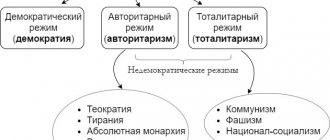Updated July 20, 2021 215 Author: Dmitry Petrov
Hello, dear readers of the KtoNaNovenkogo.ru blog.
Recently, the international community has increasingly raised gender issues.
However, many people are often confused about its subject due to a lack of understanding of the basic terms of this topic.
One of these is the concept of “gender”: what it is and whether you understand this word correctly, we will understand in our article, not forgetting about related definitions of gender and equality.
What is GENDER - definition, meaning in simple words.
In simple terms, Gender is more than male or female, and refers to your sense of who you are as a guy, girl, or whatever, as opposed to what your physical characteristics, genes, and hormones indicate. Identifying your gender (gender identity) can be more varied than simply identifying as “man” or “woman.” Different people express their gender in different ways.
Gender is how someone perceives themselves, identifies themselves internally, and how they choose to express themselves externally.
People can use their appearance, clothing style, and behavior to express the gender with which they identify.
Although genetic factors usually determine a person's biological sex, individuals determine their own gender identity. And for many of them, the gender they identify with is not the gender they were assigned to at birth, based on their physical and sexual characteristics.
The World Health Organization (WHO) views gender as a social construct that people typically describe as femininity and masculinity.
In many Western cultures, people associate femininity with women and masculinity with men, but this social construct varies.
People are equal!
In Italy, a man who cooks well is considered a real “macho”, while in Slavic countries cooking is considered a feminine activity. Because of this, as well as the preference to give leadership positions to men, conflicts arise that are regulated by gender policy:
- this refers to the state's responsibility for gender equality;
- creation of legal norms;
- creating equality.
Gender defines the behavior that should be attributed to a person based on their biological sex. This concept arose as a consequence of the development of self-awareness, as well as from the study of the feminist movement.
Story.
Gay, lesbian, bisexual, transgender, intersex and related identities have manifested themselves in different ways throughout history. All cultures included, with varying degrees of acceptance, those who practice same-sex relationships and those whose sex, gender identity, and gender expression do not conform to prevailing norms. And recently, issues of sexuality and gender have become politicized. The last fifty years have seen an increase in political activism surrounding the concept of gender and gender identity.
Female gender role
Recently, representatives of the fair half of humanity are increasingly claiming equal rights and almost duplicating the male line of behavior, earning money, holding leadership positions and serving in the military.
You may be interested in: Gestures of sympathy between a man and a woman
What are the features of the female gender role?
The female gender role in the previous understanding implies the keeper of the hearth, mother and wife. As modernity dictates its own laws, the gender role of women is changing and expanding.
The modern gender role of women has expanded. Now a lady is often not only the keeper of the hearth, but also a worker
To do this, you will have to understand what the features of the female gender role are. It lies in the fact that a woman strives to be successful, active, hardy under the prevailing rules in society that equalize both sexes. Thus, a lady must have time to manage the house, give birth to children, build a career, and also look amazing.
What is gender identity?
Gender identity is your personal understanding of your gender and how you want the world to see you.
It's how you feel on the inside and how you express your gender through clothing, behavior, and appearance. This feeling begins at a very early age.
The physical features you were born with (sex assigned at birth) do not necessarily determine your gender. And while gender has traditionally been divided into “male” and “female,” it is now widely accepted that gender is not that simple and that there are many different gender identities.
For example, you may identify with a gender that is different from the sex you were assigned at birth:
- At birth you were assigned female gender, but you identify as a man;
- You were assigned male gender at birth, but identify as female;
- you define yourself somewhere between masculine and feminine;
- you recognize yourself as some other gender identity.
Some people don't know how to define their gender identity, while others may have doubts about it.
Will genders replace sexuality?
Since biological sex and social sex are different, it is too early to talk about a complete replacement. The biological sex of a child can be determined immediately after his birth, but it is impossible to name his social sex, which will only be formed during life.
However, when we are talking about adults who are psychologically and biologically fully formed, it can be assumed that in the future people will not be divided simply into men and women, but more expanded classifications will be officially allowed.
But, again, it is impossible to replace sex with gender, since in the first case we are talking about a biological fact that can only be changed surgically, and in the second it is about human self-determination.
Genders are already divided into numerous types. Such descriptions are constantly being updated. These are social transformations that have just begun. Society partially accepts them, but on the part of males there is a greater desire to consolidate stereotypical positions.
Society is in the midst of a restructuring of values, which, according to research, has more positive than negative effects.
Types or types of genders.
There are many different words, terms and labels that people use to describe their gender or gender characteristics and identity. Here are some of the most common:
Cisgender.
A word used to describe people whose gender matches their body gender or assigned gender. For example, a cisgender man identifies as male, the gender assigned at birth.
In simple words, Cisgender is an ordinary man who feels like a man; a woman who feels like a woman.
Trans and gender diversity.
A general word used to identify people whose gender is different from their biological sex. Trans is an inclusive term because it includes all those who identify as non-binary and genderless.
Transgender.
A transgender person is a person whose gender identity or gender expression does not correspond to the sex usually assigned at birth.
Genderqueer/non-binary.
Genderqueer is someone who has a gender identity that does not match society's expectations of the sex they were assigned at birth or their assigned sex.
The term can also refer to someone who identifies as a combination of different genders. Any gender identity that falls within, outside, across, or between the spectrum of male and female binaries. A nonbinary person may identify as gender fluid, transmasculine, transfeminine, agender, bigender, etc.
Types/types of non-binary genders:
- An agender person is someone who does not identify with one specific gender or does not have one at all.
- An androgyne is someone whose gender is both feminine and masculine, or on the spectrum between feminine and masculine.
- A bigender is someone who has two genders, often demonstrating culturally and socially feminine and masculine roles.
- Genderfluid is someone who identifies as gender fluid and has a presentation and gender identity that fluctuates between or outside of society's expectations for gender.
- A gender outlaw is someone who refuses to allow society's definition of "woman" or "man" to define what they are.
- Omnigender is someone who combines all gender identities.
- Polygender and pangender are someone who experiences and exhibits aspects of different genders.
Intersex.
Intersex is a person born with reproductive organs, hormone levels, and/or sex chromosomes that are not exclusively male or female.
There are many different conditions of intersex, and they are not always obvious on the outside or even diagnosed.
Current use of the term
National governments and public organizations have been using the term “gender” extensively for a long time. They are developing a range of policies, tools and resources to ensure that their development programs take into account gender inequalities.
These strategies include mainstreaming a gender perspective into the organization, conducting gender and sexuality analyzes and gender assessments to determine the impact of programs, policies and laws.
Progress in implementing these strategies, and therefore in increasing gender awareness and gender equality, has been slow. Reasons for this include lack of commitment from stakeholders and insufficient allocation of resources.
Gaps in the collection, processing and reporting of gender-sensitive data also pose a major challenge to effective gender analysis.
Although gender issues are often recognized as important and clearly distinguished from sex issues, states and public organizations often pay less attention to them, considering other aspects of development, such as democracy, poverty or conflict, to be more relevant.
Natalia Shakhova
Sex and gender: differences.
The concepts “sex” and “gender” are often used interchangeably, despite their different meanings:
- Gender is a label (male or female) that we are assigned by a doctor at birth based on the genitalia we are born with and our chromosomes. The gender is listed on our birth certificate.
- Gender is a much more complex concept: it is a social and legal status and a set of expectations from society regarding behavior, characteristics and thoughts. Every culture has standards (stereotypes) for people's behavior depending on their gender. But rather than talking about body parts, it's more about what you're expected to do based on your gender identity.
Subjecting people to gender norms
According to Sean Byrne's research, there are three types of human conformity to social norms. The first is compliance, it manifests itself as a person’s approval of social norms that are unacceptable to him, and adjustment to them in order to avoid condemnation, punishment and in the hope of approval of his behavior by society.
Next comes approval, that is, the person’s complete agreement with the presented gender norms. The third type is identification, a person behaves in full accordance with the role model of behavior presented to him in society.
Gender and sexual orientation.
There is a significant difference between the concepts of “gender” and “sexual orientation”. Gender and sexual orientation are two different but interrelated aspects of personality.
- Gender is personal (how we see ourselves).
- Sexual orientation is interpersonal (who we are physically, emotionally and/or romantically attracted to).
Why is it so important to distinguish between these two concepts? When we confuse gender with sexual orientation, we are likely making assumptions about people that have nothing to do with who they really are. For example, when someone's gender expression is inconsistent with the expectations of others, assumptions are often made about that person's sexual orientation. A boy who likes to play princess is considered gay, and a girl who buys clothes in the “boys” department and prefers short hair may be considered a lesbian. These may be erroneous conclusions. What someone wears and how they act is a function of gender expression. You can't tell a person's sexual orientation by what they wear (for that matter, you also can't tell their gender identity unless they tell you).
The confusion of gender and sexual orientation in our society can also impact young people's ability to understand and articulate aspects of their gender. For example, transgender or non-binary people often question whether they are gay or lesbian (or any other sexual orientation other than heterosexual) before coming to a fuller understanding of their gender identity. How we come to understand our gender and sexual orientation, and the decisions we make to discover and express it, are different paths.
Classification of genders, distinctive features
Diversity is present in all aspects of life, it is a generator of agreements and disagreements, as it represents one of the main current conflicts in our society. Any type of diversity: ethnic, cultural or gender implies values such as solidarity and respect for differences. A person should live their sexual orientation and gender identity freely and responsibly.
Currently, there are three main types of gender identity:
Bipolar
Initially, bipolar identity assumed a strict differentiation of gender identity based on sex (men have exclusively masculine characteristics, and women have feminine ones).
At the end of the twentieth century, the concept of a bipolar model of gender identity was revised. At the moment, it is assumed that men and women do not necessarily conform to traditional sex role models and can combine the characteristics of both sexes in their behavior.
Multipolar
The multipolar model of gender identity allows for the existence of several options for gender identity within the same sex.
The multipolar model of gender identity is represented by 6 options:
Androgynous
Gender ambiguity is also known as androgyny.
The word "androgyny" comes from the Greek word "andro" and means man - masculinity, and the word "gyne" means woman - femininity.
Thus, androgyny, having a non-binary gender identity, means having both masculine and feminine characteristics. According to scientists, the androgyne has fulfilled the highest dream of every person: to have both sexes at the same time.
Due to the fact that androgyny refers to people who do not want to be seen/identified by their gender - they can have absolutely any appearance and sexual orientation.
By object of attraction
Describing a person's enduring physical, romantic, and/or emotional attraction to another person, that gender identity and sexual orientation are not the same thing. Non-binary genders can be straight, lesbian, gay, bisexual or queer. For example, a person who is transitioning from male to female and who is attracted exclusively to men will usually identify as a heterosexual woman.
What is gender equality?
Gender equality is when people of all genders have equal rights, responsibilities and opportunities.
Gender inequality affects everyone: women, men, transgender and agender people, children and entire families. It affects people of all ages and backgrounds. Gender equality prevents violence against women and girls, people whose biological sex does not match their gender. It is important to understand that societies in which all genders are equal are safer and healthier.
What are gender stereotypes?
A gender stereotype is a generalized idea or preconceived idea about the attributes, characteristics, or roles that different genders should possess or perform.
A gender stereotype is harmful when it limits people's ability to develop their personal abilities, pursue their professional careers, and/or make choices about their lives.
For example, the traditional view of women as childcare providers means that childcare responsibilities often fall solely on women.
Gender stereotyping refers to the practice of ascribing certain attributes, characteristics, or roles to an individual gender solely based on their membership in the social group of women or men. Gender stereotypes are unlawful if they lead to violations of human rights and fundamental freedoms.
Examples include:
- No criminalization of marital rape on the basis that women are the sexual property of men;
- Failure to investigate, prosecute and condemn sexual violence against women, believing that victims of sexual violence consented to sexual acts because they did not dress or act “modestly.”
Incorrect gender stereotypes are a common cause of discrimination against women.
The consciousness of society determines the difference
A large share of a person’s self-awareness is based on the level of culture of society and the rules that reign in it.
Some personalities are imbued with social behavior that is characterized by overly harsh judgments about a person's responsibilities based on their gender. For example, such people are confident that men have the following responsibilities:
- to be the head of the family;
- earn a lot of money;
- be aggressive and courageous;
- work only in “male” jobs;
- be a fan of sports and fishing;
- strive for maximum career growth.
Women have a similar list of “responsibilities”. For example, many people think that a woman must be soft and compliant, work only at “lady’s” jobs, get married, have children and devote all the remaining time to them.
Of course, many “rebels” appeared in society who mixed these concepts. Nowadays, many young couples refuse marriage, children, and devote their lives exclusively to satisfying their own desires.
This kind of thinking leads to conflicts based on gender. Thus, breastfeeding women can support the whole family while the man goes on maternity leave. And men who feel like women have to make sacrifices for the sake of their career. Therefore, both cases lead to gender dissimilarity among people.
Society's perception of different genders.
People who are gender diverse or who do not identify with the gender they were assigned at birth may experience a variety of stressful situations that contribute to an increased risk of mental health problems, such as:
- depression,
- self harm,
- suicidal thoughts.
However, it is important to note that gender diversity does not in itself cause mental health problems.
Here are some everyday experiences that can increase a person's vulnerability to developing mental disorders:
- feeling different from the people around you,
- bullying due to gender identity,
- Feeling pressure to reject your feelings about your gender identity
- fear or anxiety that your gender identity will be accepted by those close to you, along with the chance of being rejected or isolated,
- feeling of loneliness or misunderstanding from loved ones,
- feeling stressed and anxious about the pressure to conform to your biological sex.
This pressure can be very stressful, especially when combined with other issues in your life such as school, finding a job, forming relationships and figuring out who you are, finding your place in the world.
It is important to share your thoughts with other people who are going through the same thing as you, and also to contact specialized organizations that can support you.











